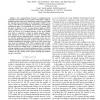Free Online Productivity Tools
i2Speak
i2Symbol
i2OCR
iTex2Img
iWeb2Print
iWeb2Shot
i2Type
iPdf2Split
iPdf2Merge
i2Bopomofo
i2Arabic
i2Style
i2Image
i2PDF
iLatex2Rtf
Sci2ools
105
Voted
GLOBECOM
2009
IEEE
2009
IEEE
Hybrid Pilot/Quantization Based Feedback in Multi-Antenna TDD Systems
— The communication between a multiple-antenna transmitter and multiple receivers (users) with either a single or multiple-antenna each can be significantly enhanced by providing the channel state information at the transmitter (CSIT) of the users, as this allows for scheduling, beamforming and multiuser multiplexing gains. The traditional view on how to enable CSIT has been as follows so far: In time-division duplexed (TDD) systems, uplink (UL) and downlink (DL) channel reciprocity allows for the use of a training sequence in any given uplink slot, which is exploited to obtain an uplink channel estimate. This estimate is in turn recycled in the next downlink slot. In frequency-division duplexed (FDD) systems, which lack the UL and DL reciprocity, the CSIT is provided via the use of a dedicated feedback link of limited capacity between the receivers and the transmitter. In this paper, we focus on TDD systems and show that the traditional TDD CSIT acquisition fails to fully exploit t...
Channel Reciprocity | GLOBECOM 2009 | Telecommunications | Training Sequence | Uplink Channel Estimate |
| Added | 20 May 2010 |
| Updated | 20 May 2010 |
| Type | Conference |
| Year | 2009 |
| Where | GLOBECOM |
| Authors | Umer Salim, David Gesbert, Dirk T. M. Slock, Zafer Beyaztas |
Comments (0)

